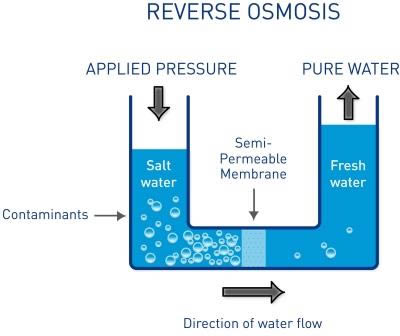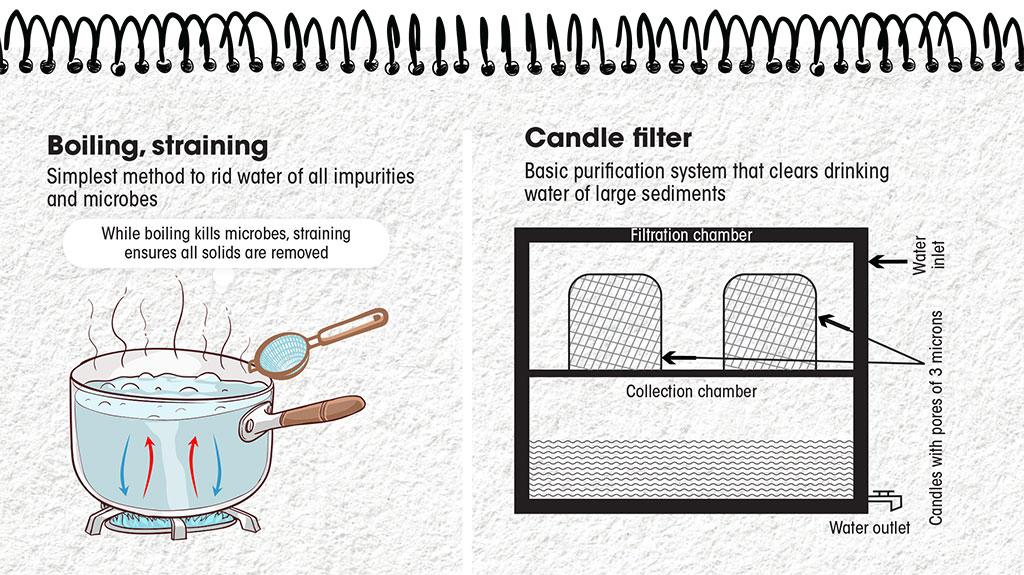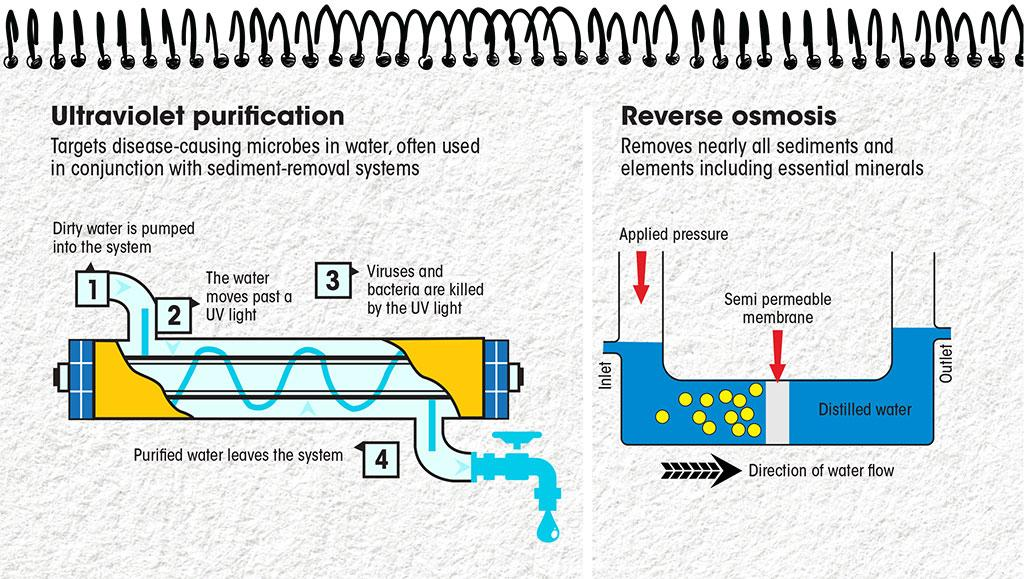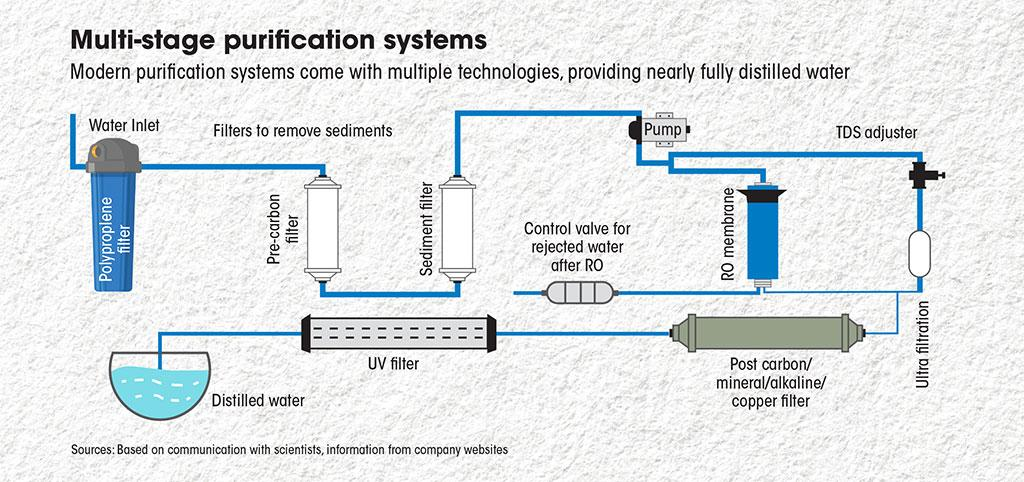Science & Technology
Purification Processes of Water
- 26 Mar 2024
- 9 min read
For Prelims: Purification Processes of Water, Reverse Osmosis (RO), TDS (Total Dissolved Solids), Dead water, WHO (World Health Organization), Bureau of Indian Standards (BIS).
For Mains: Purification Processes of Water.
Why in News?
In recent years, Reverse Osmosis (RO) has gained popularity for its ability not only to eliminate impurities and pathogens from water but also to reduce TDS (Total Dissolved Solids) levels, however, concerns arise due to the loss of essential minerals such as calcium and magnesium.
What is the RO Water Purification Method?
- About:
- RO is a water purification process that removes contaminants from water by utilising a semi-permeable membrane.
- A typical RO system consists of a semi-permeable membrane, with pores 0.0001 to 0.001 microns in size.
- In this method, water is forced through the membrane under pressure, while contaminants such as dissolved solids, chemicals, microorganisms, and other impurities are left behind.
- The membrane allows water molecules to pass through while blocking larger molecules and ions.
- The RO process effectively removes a wide range of impurities, including salts, heavy metals, bacteria, viruses, and organic compounds, producing clean and purified water.
- This technology is widely used in both residential and industrial settings to improve water quality for drinking, cooking, and various other applications.
- RO is a water purification process that removes contaminants from water by utilising a semi-permeable membrane.
- Reasons for Growing Demand for RO Water:
- Poor Water Quality: Many regions, especially rural areas, face challenges with poor quality groundwater or tap water. Issues such as brackish taste, unpleasant odour, and contamination with pollutants like chlorine or heavy metals drive people to seek alternative sources of clean drinking water.
- Perceived Health Benefits: There is a common belief among consumers that RO water is healthier and safer to drink compared to untreated or municipally supplied water.
- Despite limited scientific evidence supporting this belief, the perception of improved health outcomes associated with RO water consumption contributes to its popularity.
- Convenience and Accessibility: RO water is readily available through water purification plants and point-of-use domestic RO systems.
- This convenience, coupled with the ease of installation and maintenance, makes it a preferred choice for consumers seeking hassle-free access to clean drinking water.
- Increasing Urbanisation: Rapid urbanisation and population growth lead to higher demand for clean water, especially in urban areas where groundwater contamination and municipal water quality issues are prevalent.
- As a result, the demand for RO water purification systems rises to meet the needs of the urban population.
- Technological Advancements: Continuous advancements in RO technology have led to the development of more efficient and cost-effective water purification systems.
- These innovations make RO water more accessible and appealing to a wider range of consumers.
What are the Concerns Related to the RO Process?
- Loss of Essential Minerals:
- RO systems are highly effective at removing impurities and pathogens from water, including minerals like calcium and magnesium.
- While this purification process ensures clean water, it also leads to a reduction in essential minerals that are beneficial for human health.
- This loss of minerals, especially calcium and magnesium, can potentially contribute to micronutrient deficiencies and pose a public health threat, particularly in regions where people already suffer from such deficiencies.
- Extreme Less TDS Levels:
- In several studies, it was discovered that the Total Dissolved Solids (TDS) level was below 50 mg/l in numerous locations, indicating a significant reduction in calcium and magnesium levels.
- In one study conducted across nearly 4,000 locations nationwide, TDS levels were observed to range from 25 to 30 mg/l, signalling a scarcity of essential minerals in the water.
- RO water was found to display TDS levels of 18 to 25 mg/l in various instances, suggesting a lack of essential minerals. This is called "dead water," deemed suitable for purposes such as battery use but not for consumption.
- In several studies, it was discovered that the Total Dissolved Solids (TDS) level was below 50 mg/l in numerous locations, indicating a significant reduction in calcium and magnesium levels.
- Health Impacts:
- Research suggests that RO systems can remove significant amounts of beneficial calcium and magnesium, leading to potential health issues such as joint pain, coronary heart disease, back pain, and vitamin B12 deficiency.
- Additionally, the WHO (World Health Organization) has highlighted cases where populations experienced health problems, including cardiovascular disorders and muscular cramps, after using RO systems, indicating acute magnesium deficiency.
What are the Other Methods of Purification of Water?
What are the Recommended TDS Limits for Safe Drinking Water?
- The Bureau of Indian Standards (BIS) states that the maximum TDS limit for safe drinking water is 500 milligrams per litre (ppm).
- However, in the absence of any alternative water source, a TDS limit of 2,000 mg/l is permissible.
- In its drinking water standards issued in 2017, WHO (World Health Organization) states that TDS in drinking water should be between 600 and 1,000 mg/l.
- Countries in Europe, the US and Canada have set TDS standards at 500 to 600 mg/l.
What Technologies are Available to Address Mineral-Related Issues Within RO systems?
- To address concerns related to TDS, RO manufacturers introduced TDS controllers (or modulators) and mineral infusion cartridges (or mineralisers) for commercial and residential machines. TDS controllers help set TDS levels in purified water, while mineral cartridges inside the machine infuse specific minerals into water as it passes.
- Reduction of TDS also lowers pH, which increases the acidity of water. Hence, newer RO systems have alkaline cartridges so compounds like bicarbonates and hydrogen oxide can be infused.
Way Forward
- When assessing the need for RO, emphasis should be on the region and the condition of water.
- The RO is only necessary in areas where the surface or groundwater is hard. In many places where surface water is the source of drinking water, a combination of candles, activated carbon and UV filters is sufficient for water purification.
- While RO eliminates toxins like arsenic and fluoride, it may not be the most suitable solution if these toxic elements are the sole concern.
- In regions like Jharkhand and Odisha, where arsenic or fluoride contamination is prevalent, alternative technologies can be employed to specifically target these contaminants.
- For instance, hand pumps are still commonly used in such areas. However, once piped water reaches every household, it becomes the responsibility of the local authorities, such as the municipal corporation or panchayat, to ensure that the water supplied meets BIS standards.
Read more: Groundwater Contamination in India
UPSC Civil Services Examination, Previous Year Questions (PYQs)
Prelims
Q1. Biological Oxygen Demand (BOD) is a standard criterion for (2017)
(a) Measuring oxygen levels in blood
(b) Computing oxygen levels in forest ecosystems
(c) Pollution assay in aquatic ecosystems
(d) Assessing oxygen levels in high altitude regions
Ans: (c)
Q. Microbial fuel cells are considered a source of sustainable energy. Why? (2011)
- They use living organisms as catalysts to generate electricity from certain substrates.
- They use a variety of inorganic materials as substrates.
- They can be installed in waste water treatment plants to cleanse water and produce electricity.
Which of the statements given above is/are correct?
(a) 1 only
(b) 2 and 3 only
(c) 1 and 3 only
(d) 1, 2 and 3
Ans: (d)
Mains
Q. The effective management of land and water resources will drastically reduce the human miseries. Explain. (2016)









